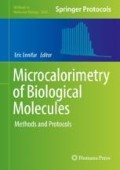Abstract
Isothermal titration calorimetry (ITC) has become the preferred experimental technique for characterizing intermolecular interactions between biological molecules. Among the several advantages, the use of natural non-labeled molecules and the determination of the complete thermodynamic profile for the interaction in solution remain as the primary features that have promoted ITC to the forefront of experimental biophysics. The experimental design in ITC may range from studying a simple direct binary macromolecule-ligand interaction to studying the homotropic or heterotropic cooperative effect between ligands when interacting with a given macromolecule. The theory of the binding polynomial has proven to be an appropriate unifying framework for handling the complexities that can be encountered when studying macromolecule-ligand interactions, though it has been deemed troublesome. The goal of this chapter is to provide a quite simple and widely available set of training experiments aimed at mastering the formalism of the binding polynomial applied to isothermal titration calorimetry.
Access this chapter
Tax calculation will be finalised at checkout
Purchases are for personal use only
References
Freire E (2015) The binding thermodynamics of drug candidates. In: Keseru GM, Swinney DC (eds) Thermodynamics and kinetics of drug binding, 1st edn. Wiley-VCH, Weinheim
Kawasaki Y, Freire E (2011) Finding a better path to drug selectivity. Drug Disc Today 16:985–990
Schön A, Madani N, Smith AB, Lalonde JM, Freire E (2011) Some binding-related drug properties are dependent on thermodynamic signature. Chem Biol Drug Des 77:161–165
Velazquez-Campoy A, Goñi G, Peregrina JR, Medina M (2006) Exact analysis of heterotropic interactions in proteins: Characterization of cooperative ligand binding by isothermal titration calorimetry. Biophys J 91:1887–1904
Velazquez-Campoy A (2016) Allostery and cooperative interactions in proteins assessed by isothermal titration calorimetry. In: Bastos M (ed) Biocalorimetry: foundations and contemporary approaches. CRC Press, Boca Raton, pp 223–246
Gill SJ (1989) Thermodynamics of ligand binding to proteins. Pure Appl Chem 61:1009–1020
Wyman J, Gill SJ (1990) Binding and linkage: functional chemistry of biological macromolecules. University Science Books, Mill Valley
Freire E, Schön A, Velazquez-Campoy A (2009) Isothermal titration calorimetry: general formalism using binding polynomials. Methods Enzymol 455:127–155
Vega S, Abian O, Velazquez-Campoy A (2015) A unified framework based on the binding polynomial for characterizing biological systems by isothermal titration calorimetry. Methods 76:99–115
Zhang YL, Zhang ZY (1998) Low-affinity binding determined by titration calorimetry using a high-affinity coupling ligand: a thermodynamic study of ligand binding to protein tyrosine phosphatase 1B. Anal Biochem 261:139–148
Bradshaw JM, Mitaxov V, Waksman G (1999) Investigation of phosphotyrosine recognition by the SH2 domain of the Src kinase. J Mol Biol 293:971–985
Sigurskjold BW (2000) Exact analysis of competition ligand binding by displacement isothermal titration calorimetry. Anal Biochem 277:260–266
Velazquez-Campoy A, Ohtaka H, Nezami A, Muzammil S, Freire E (2004) Isothermal titration calorimetry. Curr Protoc Cell Biol Unit 17(8):1–24
Velazquez-Campoy A, Leavitt SA, Freire E (2015) Characterization of protein-protein interactions by isothermal titration calorimetry. Methods Mol Biol 1278:183–204
Griko YV (1999) Energetics of Ca(2+)-EDTA interactions: calorimetric study. Biophys Chem 79:117–127
Arias-Moreno X, Cuesta-Lopez S, Millet O, Sancho J, Velazquez-Campoy A (2010) Thermodynamics of protein-cation interaction: Ca(+2) and Mg(+2) binding to the fifth binding module of the LDL receptor. Proteins 78:950–961
Hinz HJ, Shiao DDF, Sturtevant JM (1971) Calorimetric investigation of inhibitor binding to rabbit muscle aldolase. Biochemistry 10:1347–1352
Goldberg RN, Kishore N, Lennen RM (2002) Thermodynamic quantities for the ionization reactions of buffers. J Phys Chem Ref Data 31:231–370
Krainer G, Keller S (2015) Single-experiment displacement assay for quantifying high-affinity binding by isothermal titration calorimetry. Methods 76:116–123
Houtman JC, Brown PH, Bowden B, Yamaguchi H, Appella E, Samelson LE, Schuck P (2007) Studying multisite binary and ternary protein interactions by global analysis of isothermal titration calorimetry data in SEDPHAT: application to adaptor protein complexes in cell signaling. Protein Sci 16:30–42
ITC data analysis in Origin (2004) Tutorial guide. Malvern-MicroCal
Acknowledgments
This work was supported by Spanish Ministerio de Economia y Competitividad [BFU2013-47064-P and BFU2016-78232 to AVC]; Fondo de Investigaciones Sanitarias [PI15/00663 and PI18/00349 to OA]; Spanish Ministerio de Educacion, Cultura y Deporte [FPU13/3870 to RCG]; Miguel Servet Program from Instituto de Salud Carlos III [CPII13/0017 to OA]; Diputacion General de Aragon [B136/13 to RCG, Digestive Pathology Group B01 to OA and RCG, Protein Targets Group B89 to AVC]; Centro de Investigacion Biomedica en Red en Enfermedades Hepaticas y Digestivas (CIBERehd); and Asociacion Española de Gastroenterologia (AEG).
Author information
Authors and Affiliations
Corresponding author
Editor information
Editors and Affiliations
Rights and permissions
Copyright information
© 2019 Springer Science+Business Media, LLC, part of Springer Nature
About this protocol
Cite this protocol
Claveria-Gimeno, R., Vega, S., Abian, O., Velazquez-Campoy, A. (2019). Tinkering with Binding Polynomials in Isothermal Titration Calorimetry. In: Ennifar, E. (eds) Microcalorimetry of Biological Molecules. Methods in Molecular Biology, vol 1964. Humana Press, New York, NY. https://doi.org/10.1007/978-1-4939-9179-2_14
Download citation
DOI: https://doi.org/10.1007/978-1-4939-9179-2_14
Published:
Publisher Name: Humana Press, New York, NY
Print ISBN: 978-1-4939-9178-5
Online ISBN: 978-1-4939-9179-2
eBook Packages: Springer Protocols

